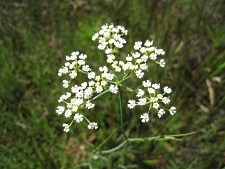Wildlife - Species

Canby's Dropwort (Oxypolis canbyi)
Description
Canby's dropwort belongs to the mint family (Apiaceae). It is a perennial herb which grows from 80 to 120 cm (30 to 50 in) tall. The "quill-like" hollow leaves and the thick, corky wings that extend out from the margins of the fruit are the most distinctive features of the plant. The stems are erect or ascending, round, and slender with arching/ascending or forking branches above the mid-stem. The flowers are monoecious or dioecious (flowers have either male or female parts or both) and small and white, sometimes tinged with red or pink. The flowers are borne on compound umbrella-like structures that extend from the base of the leaves, and the fruit is a schizocarp (fruit splits into one-seeded segments) about 4-6 mm long.
Preferred Habitat and Biology
Canby's dropwort is found in Delaware and Maryland and from North Carolina to Georgia. The plant inhabits a variety of coastal plain communities, including pond cypress savannahs, the shallows and edges of cypress/pond pine ponds, sloughs, and wet pine savannas. In the ACE Basin, the species grows in wetlands within the Colleton County Cowbane Preserve.
Canby's dropwort reproduces asexually by means of rhizomes, or lateral, underground rootstocks. Very little data are available on the life history and reproductive biology of the species. Boyer (pers. comm. 1988) with the North Carolina Plant Conservation Program conducted growth experiments and had some success with growing plants vegetatively but little success with germinating seeds. Her findings indicated that dropwort grows better on water-saturated soils than on intermittently dry soils. This may explain why the largest populations of dropwort occur in wetlands that are flooded most of the year.
Species Significance
Canby's dropwort was federally listed as endangered on February 25, 1986. Only 25 populations of the species are currently known to exist, one of which is found in the ACE Basin. The site of this population in the ACE is on state-owned land, so it is protected from habitat alterations. The most serious threat to the population is drought or too much rain. For example, two populations of Canby's dropwort in South Carolina were monitored during the severe drought of 1986. One population was located in Bamberg County, and the other was in Colleton County. During the drought, the water level at the Bamberg site dropped 33 cm (13 in) below the surface, while at the Colleton site the level dropped 177 cm (70 in) below the surface. At the Colleton County site, the population went from 500 plants in 1982 to fewer than five in 1986, presumably as a result of the drought, whereas the Bamberg site showed a slight decrease (Rayner 1988). No horticultural, medicinal, or other economic uses of the plant are known at this time.
References
Aulbach-Smith, C. 1985. Element stewardship abstract for Oxypolis canbyi. The Nature Conservancy, South Carolina Office, Columbia, SC.
Murdock, N. and D. Rayner. 1990. Recovery plan for Canby's dropwort (Oxypolis canbyi [Coulter and Rose] Fernald). U.S. Department of the Interior, Fish and Wildlife Service. Atlanta, GA.
Rayner, D.A. 1984. Inventory of botanical natural areas in Colleton County, South Carolina. SC Wildlife and Marine Resources Department, Division of Wildlife and Freshwater Fisheries, Columbia, SC.
